As someone who has had their fair share of battles with Whirlpool washers stuck on sensing, I understand the frustration.
Luckily, most Whirlpool washers that are stuck in sensing limbo aren’t actually broken! Most of the time, the cause is something that you can DIY-fix.
This article walks you through the troubleshooting steps, potential causes, and solutions for this problem.
Let’s get into it.
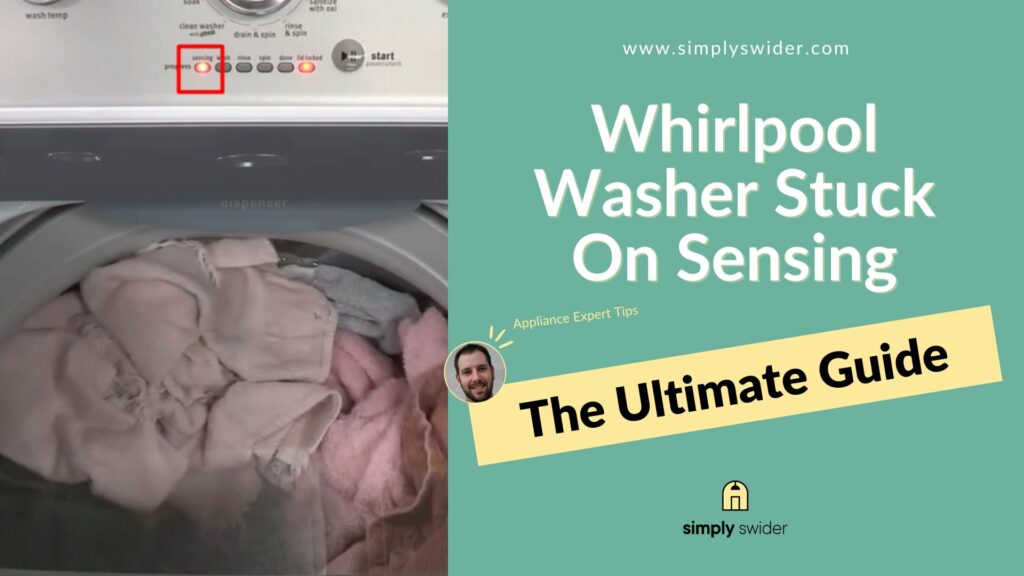
Table of Contents
Why is My Whirlpool Washer Stuck On Sensing?
By design, a Whirlpool washer should take about 3 minutes in the sensing stage. If it gets stuck and won’t proceed to the wash cycle, it can be due to various reasons, including a faulty actuator switch, a problem with the water inlet valves, a malfunctioning drive motor, or issues with the control board.
But how do you know the specific cause? Well, keep reading; I’ve got you covered.
Here is the thing:
While I have dealt with many Whirlpool washer models, I haven’t encountered every single model.
That’s why I reached out to Joe Willis, a professional appliance repair technician based in Columbus, Ohio, so that we could compare notes.
What Is Sensing In A Whirlpool Washer?
Now:
Before we get too deep into the topic, let’s talk briefly about auto-sensing.
After closing the lid and pressing the start button, the washer goes into sensing mode.
Here is how the process works:
- The lid locks. You’ll hear the familiar clicking sound.
- Slight basket movements occur.
- The lid unlocks and locks again.
- Short, slow spins for 2-3 minutes.
- Water is added to the load.
- The process continues until sufficient water is added.
During this time, the washer senses the load weight and determines the right amount of water.
This process involves a number of parts and sensors.
| Parts involved during sensing | Sensors involved |
|---|---|
| Actuator switch Motor Control board Drive belts Water inlet valves Sensors Capacitor Motor coupler | Load size sensor Water level sensor Water temperature sensor Door lock sensor The balance sensor Soil level sensor |
Why is this important?
According to Joe…
“The common culprits for a washer stuck in sensing are the parts and sensors involved during the process.”
Let’s not get into the causes and fixes.
7 Reasons Why Whirlpool Washer Stuck On Sensing
| Commonly Affected Parts | Part Replacement Cost |
|---|---|
| Actuator Switch | $20-$100 |
| Water inlet valve | $20-$150 |
| Control board | $200-$600 |
| Drive belt | $10-$60 |
| Motor | $200-$700 |
| Capacitor | $50-$200 |
| Motor coupling | $10-$30 |
1. Bad Actuator Switch
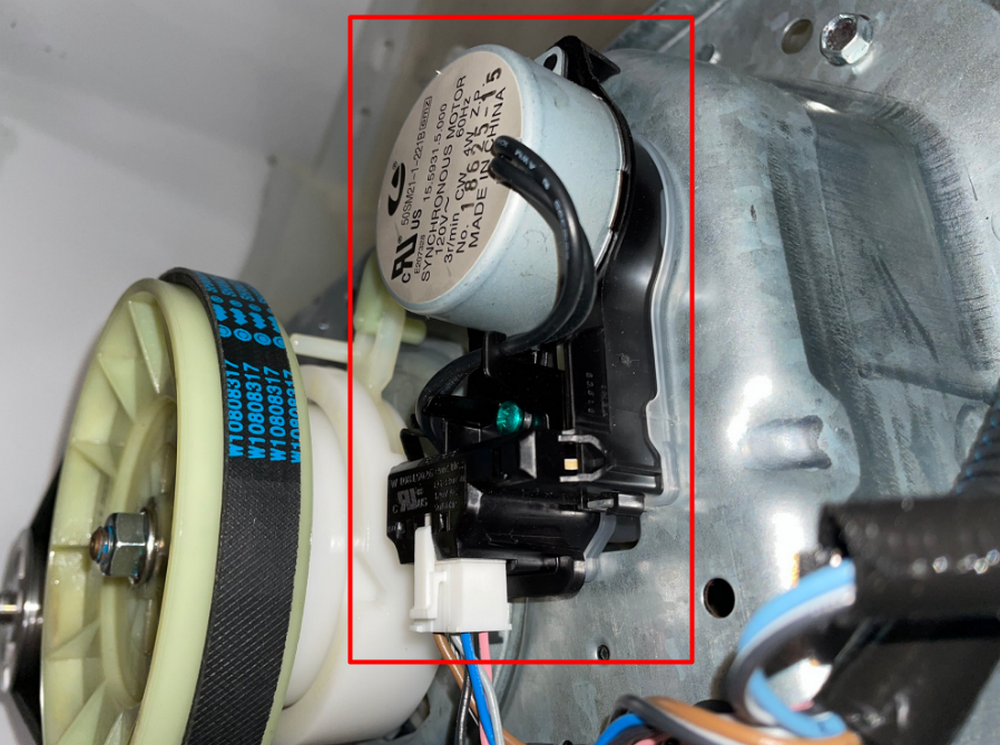
| Part | Actuator Switch |
| Location | At the bottom of the washer |
| Ease of troubleshooting | Medium |
| Replacement part cost | $20-$100 |
| Repairable | No |
Problem:
Both Joe and I have frequently encountered issues with the shift actuator and concur that it’s one of the most common causes of this problem.
And if you look in our Simply Swider Appliance Repair Community, most of the reported cases are directly related to a faulty shift actuator.
Now:
The shift actuator is the part that switches the washer from agitation to spinning by disengaging and engaging the necessary gear.
However:
If the shift actuator fails, the drum won’t move, which is necessary for the washer to determine the load weight.
Why?
This is because the shift actuator won’t engage the transmission to allow for a slow rotation of the drum.
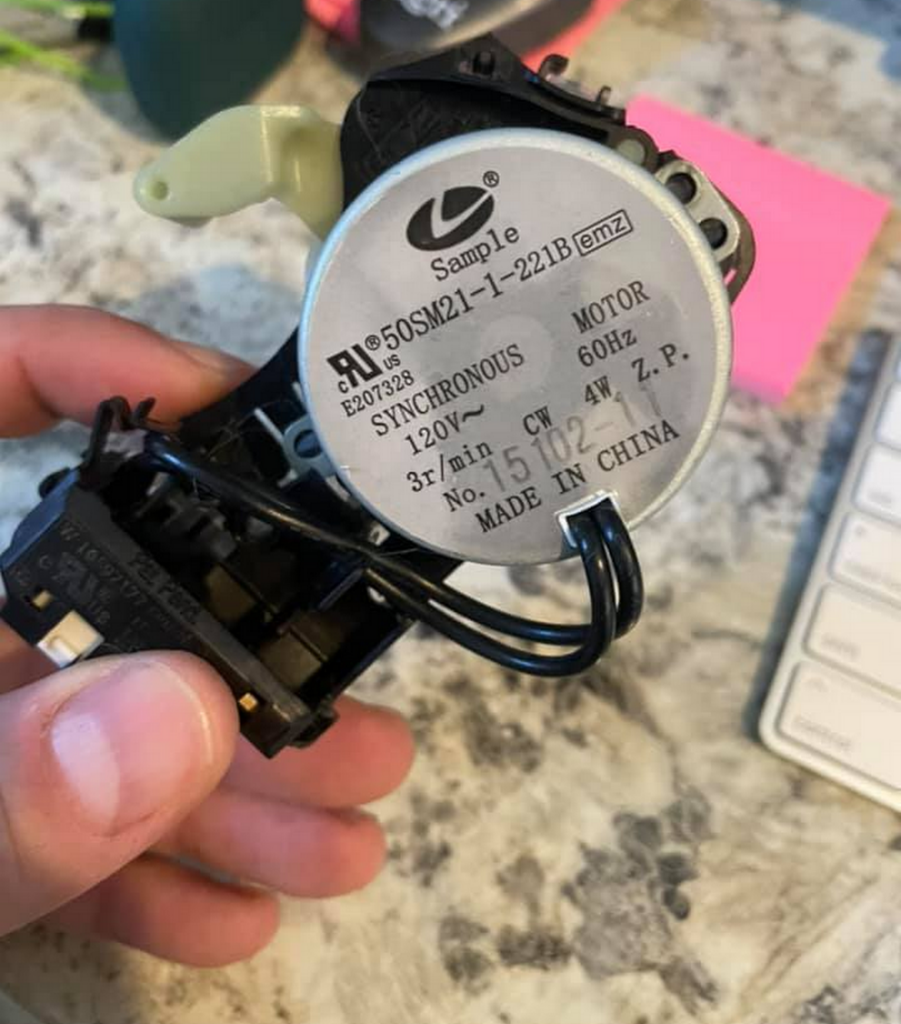
Identification:
The first sign that the shift actuator could be to blame is if the washer is not spinning the load during sensing.
Secondly:
If there are grinding or clicking noises as the actuator tries to engage the transmission.
Next:
Locate the shift actuator, which is typically at the bottom of the washer, and do a visual inspection.
Joe says…
“Inspect it for signs of damage, such as burned parts, damaged wires, broken parts, and corroded electrical connections.”
To add to this:
Check if the washer is displaying a shift actuator-related error code.
Solution:
The fix here will depend on the specific issue with the shift actuator. The table below highlights some of the repairable and nonrepairable issues.
| Repairable Issues | Issues That Require Replacement |
|---|---|
| Loose connections | Mechanical failure of some of the internal components |
| Obstructions by debris | Electrical issues such as a burnt-out sensor or motor |
| Misalignment | Broken housing |
| Seized components |
2. Sensors Need Calibration
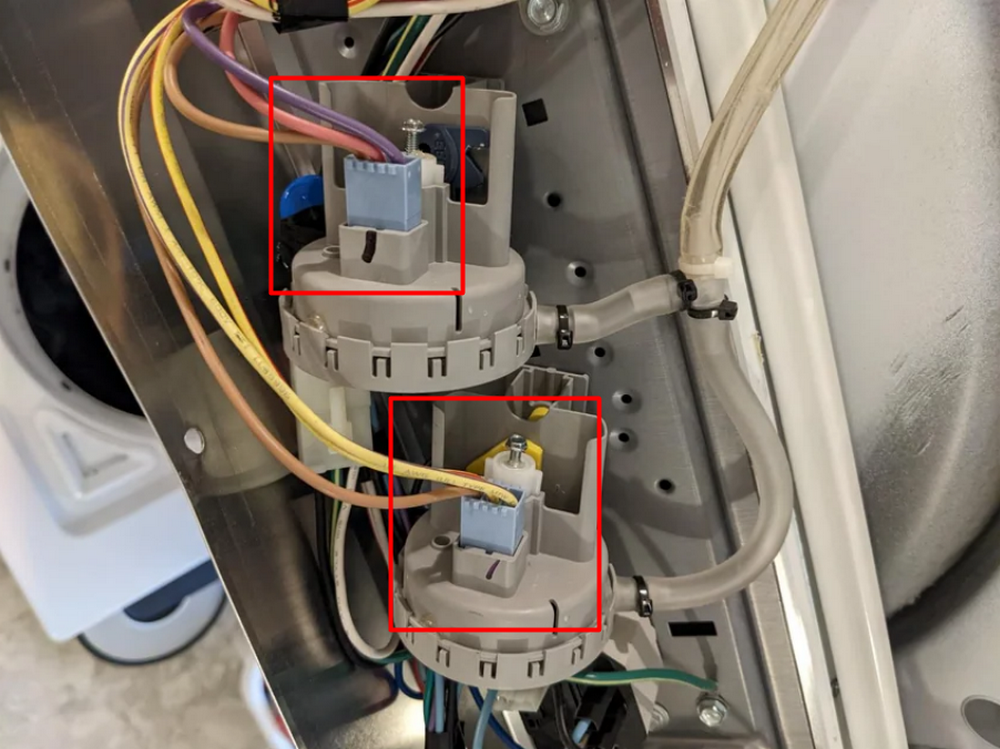
Problem:
Sensors that need calibration could also be to blame.
Here is the thing:
The sensing phase in washing machines uses sensors to determine factors such as the weight of the load, the water level, and the water temperature.
Joe says…
“If any of the sensors isn’t calibrated correctly, the washer could get stuck.“
Calibration ensures that the sensor’s readings are accurate.
Identification
There are a few signs that are possible indicators that a sensor isn’t calibrated properly.
- If the washer is filling with less or more water.
- When the washer is displaying a sensor-related error code.
- If the washer is brand new or it has just been installed or moved.
- Water temperature issues.
- Washer showing longer cycle durations.
Solution:
To recalibrate the sensors, you will use the recalibration reset process, which can differ from one Whirlpool model to another.
Below is the most common recalibration reset method for most Whirlpool models
- Step 1: Unplug the washer from the power source for 3 minutes, and then reconnect it.
- Step 2: Put the cycle selector dial to ‘normal’.
- Step 3: Rotate the dial counterclockwise in a full 360-degree motion a few times. Set it to the ‘normal’ position and pause for 3-4 seconds.
- Step 4: Starting at ‘normal’, turn the dial in the following order.
1 click to the Left, 3 clicks to the Right, 1 click to the Left, and 1 click to the Right

- Step 5: Rotate the cycle selector dial 4 clicks to the right until only the rinse LED light is lit.
- Step 6: Hit the start button.
The washer will enter recalibration mode, which will take up to 3 minutes.
This user in our community fixed the same issue by recalibrating their Whirlpool WTW5500XW3 washer.
3. Water Inlet Valves Problems
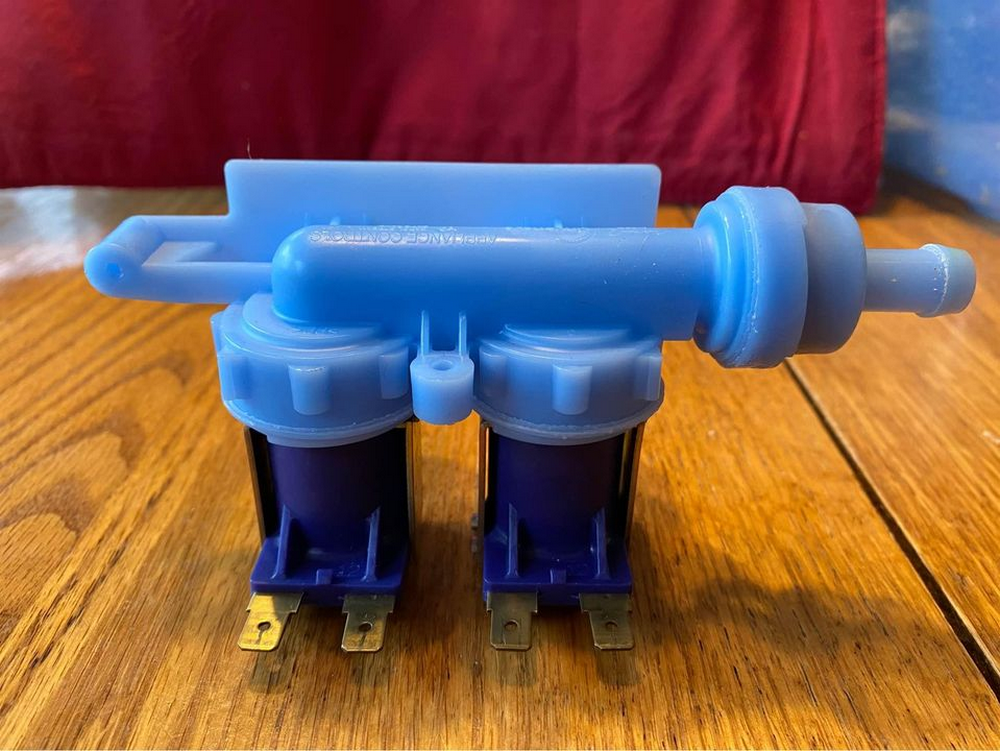
| Part | Water inlet valve |
| Location | Connected to the water supply hoses |
| Ease of troubleshooting | Hard |
| Replacement part cost | $20-$150 |
| Repairable | No |
Problem:
The water inlet valve is the component that regulates the flow of water into the washer following signals from the control board.
During the sensing phase, the washer determines the amount of water to add depending on the size of the load.
However:
Sometimes, the water inlet valves malfunction and don’t let in the right amount of water as specified by the control board.
While I’ve only encountered situations where the issue lies with the water inlet valves, Joe shared instances where he found the problem was either the hot or cold water supplies.
Some of the most common problems with water inlet valves include
- The valves getting clogged or blocked
- Loose connections
- Damaged wiring
- Faulty solenoids
- Valves not opening
Identification:
Troubleshooting the water inlet valves is a combination of visual inspection and mechanical testing.
Joe says…
“Start by observing the flow of water during sensing and determining if it looks normal or restricted.“
Next:
Run the washer in diagnostic mode and see if it displays any related error codes.
For instance:
Recently, I was called to fix a Whirlpool WTW5000D washer that wouldn’t proceed from the sensing cycle.
After putting the washer in diagnostic mode, I got the F8E3 error code. I replaced the water inlet valve, and the issue was fixed.
Joe also recommends listening for a hissing sound coming from the water inlet valves, which could mean the solenoids are struggling.
While you are here:
- Confirm your home water supply has adequate pressure.
- Ensure the water valves are fully open.
- Examine the hose for twisting and kinks.
- Check the washer for water inlet valve-related error codes.
- Inspect the inlet valves for cracks and damage.
- Check if there is any clog or blockage.
- Use a multimeter to test the resistance on the solenoid terminals.
Solution:
If you are dealing with a clogged water inlet valve, clean it by flushing it with water.
In the case of low water pressure in your main water supply, call your water company.
On the other hand:
If the issue is faulty solenoids or if the unit is damaged, replace the entire water inlet.
4. Control Board Issues
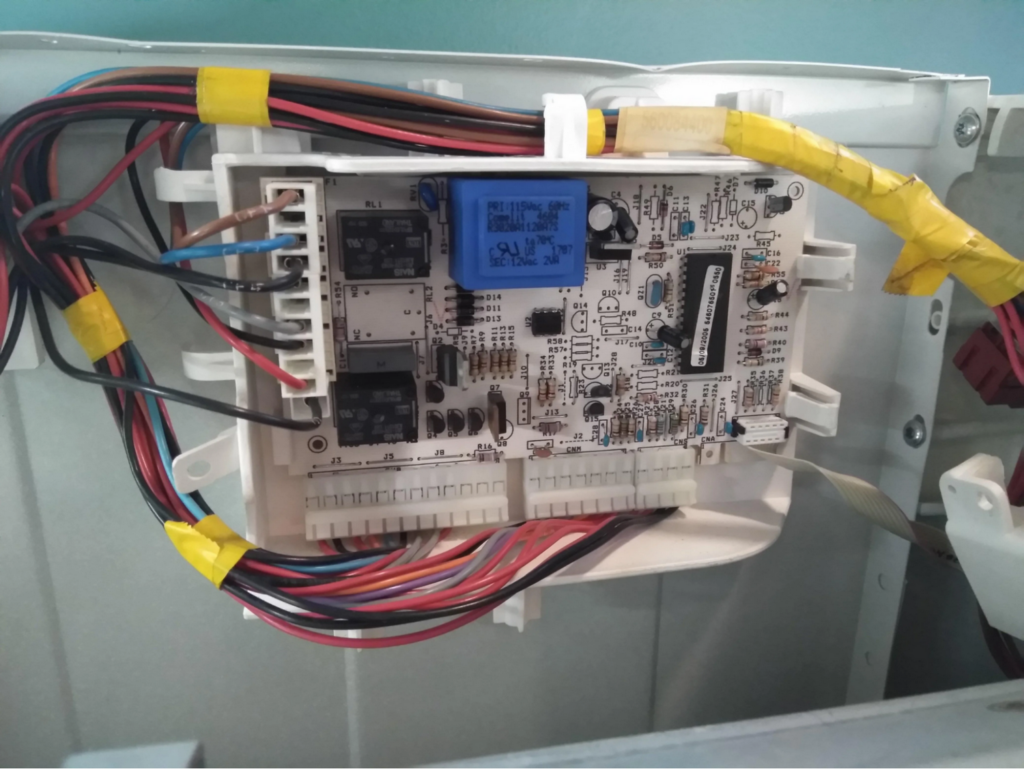
| Part | Control board |
| Location | Behind the front panel |
| Ease of troubleshooting | Hard |
| Replacement part cost | $200-$600 |
| Repairable | Yes |
Problem:
One of the parts that is heavily involved during the sensing is the control board.
Basically:
It serves as the brain of the washer, controlling and sequencing all the functions during sensing.
However:
A faulty or malfunctioning control board won’t send the necessary signals to allow sensing complete.
However, and I agree with Joe, the control board is the hardest component to test and repair.
Some of the common problems with the control board include
- Miscommunication between the control board and other parts such as sensors and the motor.
- Inability to control the water inlet valves.
- Software glitch.
- Faulty timers.
Identification:
To check for control board issues there are several things you should do
- Check for control board-related error codes.
- Conduct a visual inspection for blown capacitors, burn marks, and loose connections.
- Use a multimeter to test for continuity across fuses, relays, and capacitors.
Solution:
The first line of defense for control board-related problems is resetting the washer and cleaning the board using a soft brush or compressed air.
If this does not solve the issue, repair any faulty parts or replace the entire board.
Joe says…
“Some issues, like broken relays and capacitors and loose connections, are easy to diagnose and fix, unlike power surges or water damage”.
Should all the aforementioned efforts prove futile, seek the expertise of a qualified technician.
5. Broken Drive Belt
| Part | Drive belt |
| Location | Underneath the drum or tub |
| Ease of troubleshooting | Easy |
| Replacement part cost | $10-$60 |
| Repairable | No |
Problem:
During the sensing cycle, the washer moves the tub to determine the load size and the right amount of water.
As Joe explains…
“The drum is moved by the drive belt that is connected to the motor. If the drive belt is faulty, the drum cannot spin, and hence the washer won’t start.”
Identification:
From my experience, the first signs that the drive belt could be having problems are a burning smell or noises coming from under the washer.
The next thing is to inspect the drive belt for
- Wear and tear
- Loss of tension from stretching
- Splitting or cracking
- Glazing from slipping
- Misalignment
- Breaking
Solution:
If it’s a misalignment issue, tighten the belt and align it properly.
Should an inspection reveal damage to the drive belt, replace it.
Luckily, it’s inexpensive and easy to replace, as you can see in this YouTube video.
6. Issues with the Motor
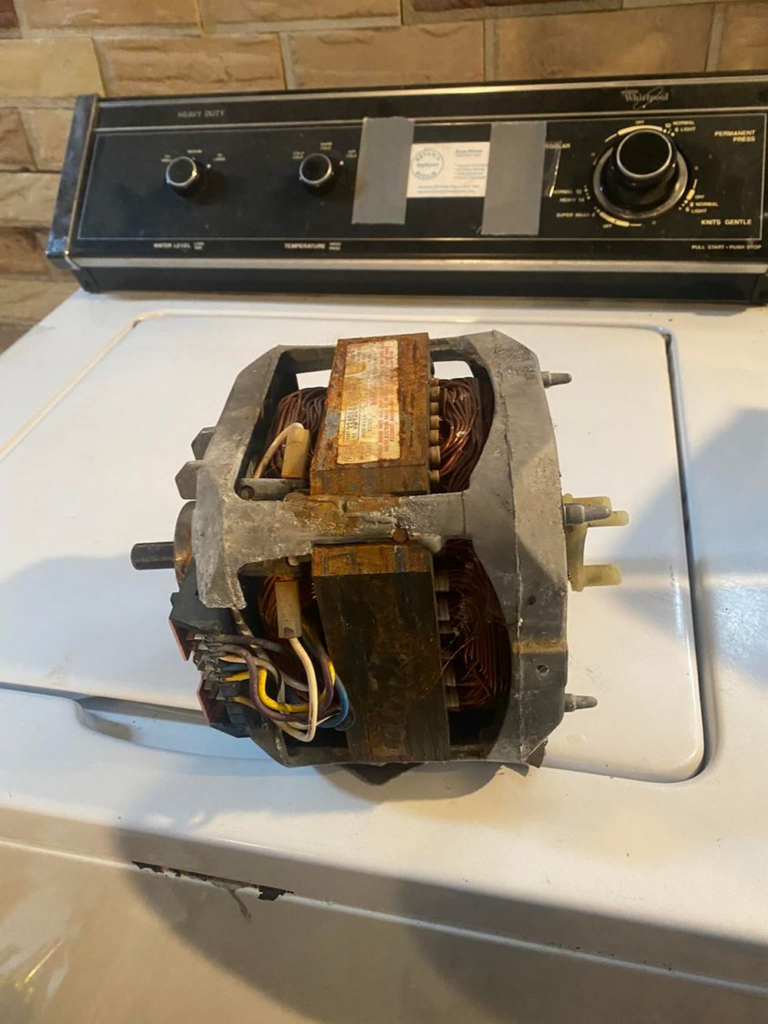
| Part | Motor |
| Location | Under the tub or drum |
| Ease of troubleshooting | Hard |
| Replacement part cost | $200-$700 |
| Repairable | Yes |
Problem:
Although it’s uncommon, a broken motor can also result in the washer getting stuck on sensing.
In this case:
The washer won’t move the drum, which is required to determine the weight of the load and the amount of water to add.
Identification:
According to Joe, “If the motor has a problem, there won’t be any tub movement after pressing the start button.”
The next thing is to inspect the motor for:
- Loose or damaged connections
- Seized bearings
- Worn brushes,
- Overheating
- A bad capacitor
- Worn out motor couplers
A few ways to test the motor include
- Visual inspection.
- Measuring resistance across motor windings.
- Spinning the motor shaft manually to test the bearings.
Solution:
“If the issue with the motor is worn brushes, blockage, or faulty connections, you are lucky since these issues are repairable,” Joe explains
However:
In the case of damaged windings, seized bearings, or a worn-out motor, you will need to replace the motor.
7. Other Culprits
The above six causes are the most common that we have come across.
However, there are a few other culprits worth mentioning.
- A dead capacitor. When the capacitor is faulty the motor won’t get the initial burst of energy it needs to start and hence the washer won’t complete sensing.
- Worn out or broken motor coupling – in this case, power from the motor won’t be transferred to the transmission, hence the washer won’t spin.
- The washer may be stuck because of a software glitch. Here, you will need to reset the washer.
Most Affected Models
Here is the thing:
There is no Whirlpool washer model that is immune from this issue. Luckily, this guide applies to almost every model, including these ones.
- Whirlpool Duet
- Whirlpool Cabrio WTW4900BW0
- Whirlpool Washer WTW5000DW1
- Whirlpool H2low
- Casio Whirlpool Washer
- Whirlpool Model WTW5610XW3
- Whirlpool WTW5610XW3
- Whirlpool Washer WTW5000DW3
- Whirlpool Washer WTW5000DW0
- Whirlpool WTW5000D
- Whirlpool WTW5105HW
- Whirlpool WTW4616FW
- Whirlpool WTW5500XW3
- Whirlpool WTW4950HW1
- Whirlpool WTW5010LW0
- Whirlpool WTW5000DW3
- Whirlpool WTW4816FW2
- Whirlpool WTW5057LW0
- Whirlpool WTW5000DW1
- whirlpool WTW4816FW2
- Whirlpool WET4024HW
- Whirlpool WFW3090JW
- Whirlpool WTW5840BW0
- Whirlpool WTW4955HW1
- Maytag Centennial MVWC200XW1
Conclusion
There’s little more aggravating than a mountain of dirty laundry and a Whirlpool washer that’s stuck on sensing.
Fortunately, most of the causes are relatively easy to troubleshoot and fix.
This guide has addressed the most common causes, including a faulty actuator switch, problems with the control board, and issues with the water inlet valve.
To identify the specific cause, start by resetting and running the washer in diagnostic mode to see if it displays any error codes that will point you in the right direction.
If there is no error, go through each of the culprits we’ve discussed until you can pinpoint the sneaky mastermind.
Look out for replacement parts on Whirlpool, eBay, and Amazon.
But hey, if all else fails and you’re left scratching your head, seek the help of a professional.
You can also post your issue in our Expert Community for free advice and consultation.
Frequently Asked Questions
The major causes of this issue are problems with one of the parts that are involved during sensing.
Some of the most common culprits include a faulty actuator switch, a malfunctioning motor, a damaged belt, and issues with the control board.
Other possible causes include the washer being stuck because of a software glitch or uncalibrated sensors.
If you are dealing with a washer that regularly gets stuck on sensing, I recommend diving deep until you find the exact cause.
Mostly, you will find a component that is deteriorating. For instance, partially clogged valves, a faulty sensor, and a control board problem.
There are a few things you can do to minimize the chances of finding yourself in this situation again and again.
They include regularly inspecting the water inlet valves, calibrating the sensors periodically, and performing proper maintenance.

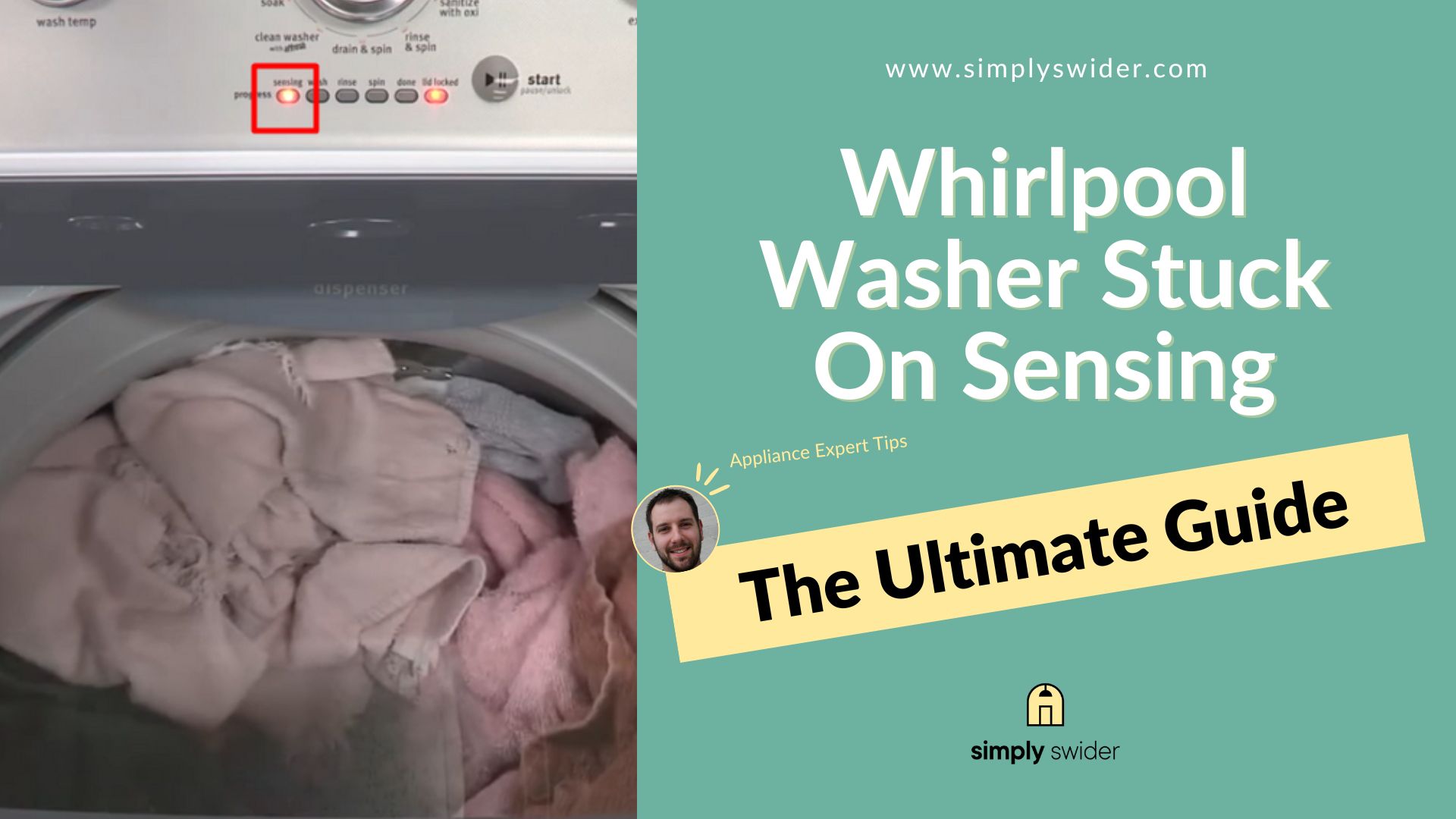
Whirlpool wtw4816fw2 washer. Original problem was the cold water was very slow to fill. I ran a diagnostic resulting in an F0E0 (only the sensor led flashed. I checked the water supply, hoses ans inlet screens and the were OK. I replaced the water inlet valve and the washer worked fine for 2 loads then on the 3rd the tub would fill for 15 seconds and stop. Followed by a hum with clicking but no water. I then tried 4 different ways to reset and calibrate the machine but that did not correct the problem.
I’m not sure what to do next and I don’t want to replace the control board until I have exhausted all other options.